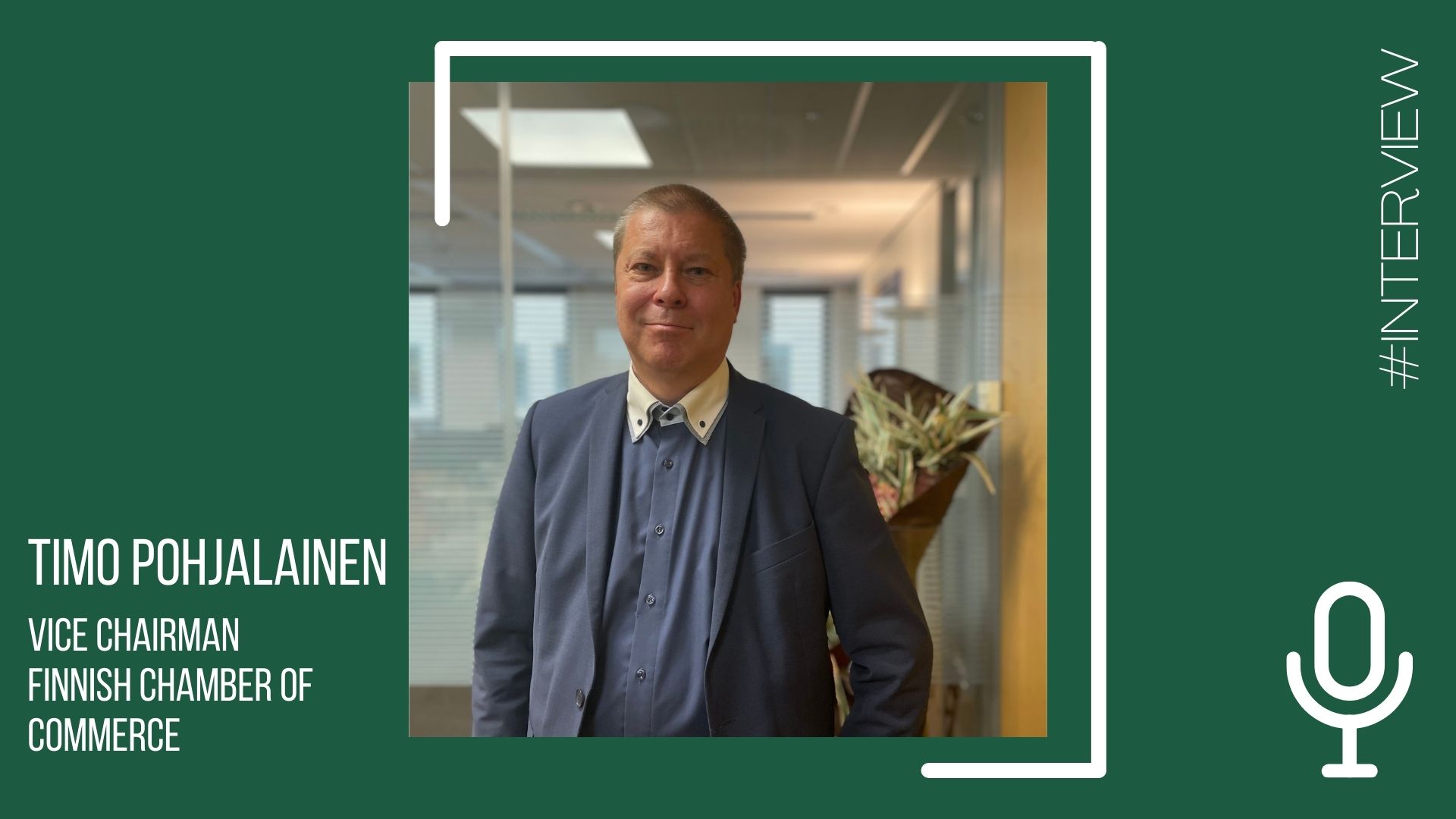
As part of an ongoing series of discussions held with members of the diplomatic and international business community in Hungary, we had the privilege to conduct an in-depth interview with Mr. Timo Pohjalainen, Vice Chairman of the Hungarian Finnish Chamber of Commerce.
The interview is included in our portfolio together with the ambassadors of Austria, Brazil, Estonia, India, Italy, and Morocco and with the Minister Counselor at the Serbian Embassy in Budapest.
This conversation provided an insightful and comprehensive understanding of various aspects related to commerce, bilateral relations, and the business landscape within the Hungarian-Finnish context.
Could you present your involvement with the Chamber of Commerce and the Chamber of Commerce activities?
I serve as Vice Chairman and as a board member on a voluntary basis within the Hungarian Finnish Chamber of Commerce. Nevertheless, I give this interview as a private person; not representing the finnish chamber of commerce or any other third party.
Initially, the management of trade affairs was under the purview of the Finnish Embassy. However, approximately a decade ago, the embassy withdrew from direct involvement. Since then, the Chamber of Commerce has been independently operational, although it maintains robust connections with the embassy.
The core focus of the Chamber of commerce revolves around assisting Finnish businesses in Hungary and Hungarian companies in their commercial endeavors in Finland. This emphasis is underscored by English being our primary working language, fostering an environment of inclusivity for all stakeholders involved.
Additionally, it is important to note the active involvement of the Finnish Institute FinnAgora in Hungary. The institute passionately fosters collaboration across cultural, scientific, and economic domains between Finland and Hungary.
Do you know how many Finnish companies are active in Hungary?
We as the Chamber of Commerce work mostly with the 20 major companies. However, I would estimate that the current active presence of Finnish companies in Hungary is fewer than 100.
During Nokia Mobile’s active operations in Hungary, with multiple factories dedicated to manufacturing Nokia mobile phones, Finnish companies collectively employed 20,000 individuals. There was a substantial decline in employment when Nokia Mobile Phones ceased its operations in the country.
At present, I would approximate that Finnish companies employ approximately 4,000 individuals in Hungary.
Can you introduce to our readers the Finnish Chamber of Commerce and what support and resources does it offer to businesses seeking to enter or expand in the Hungarian market?
As previously mentioned, we conduct our work on a pro bono basis, and naturally, our available time is limited. Our board comprises six members who are primarily responsible for all operational tasks.
Essentially, what we do is act as intermediaries. When individuals or businesses reach out to us through our contact page, we connect them with relevant Hungarian and Finnish contacts capable of assisting them.
Acknowledging the constraints of our pro bono work, we do not operate on a very large scale. But despite our limitations, we have successfully facilitated connections for numerous companies and individuals seeking the right partners in Hungary.
Furthermore, we regularly arrange networking events, providing a platform for individuals to share information in co-operation with the Finnish Embassy. The Finnish Embassy hosts similar networking events twice a year.
When did the Finnish Chamber of Commerce in Hungary open its doors?
Thirty-three years ago, the Finnish Chamber of Commerce in Hungary was inaugurated as a trade section of the embassy, initially comprising a smaller consortium of companies forming a trade guild.
Over time, significant growth ensued, notably with Nokia’s entrance into Hungary, establishing large mobile phone factories in Komárom and Pècs, where they produced an impressive 150 million phones annually.
Can you provide an overview of the current state of trade relations between Finland and Hungary and on how trade and economic relations evolved in recent years?
In the landscape of trade relations between Finland and Hungary, key product as vehicles (cars), electronic equipment, machinery, technical and medical apparatus emerge as the principle Hungarian export to Finland. As economic ties continue to evolve, the bilateral exchange of these varied commodities remains a testament to the multifaceted nature of their trade relations.
Agricultural products represent Hungary’s fifth largest export to Finland, encompassing goods such as honey, fresh and frozen fruits, and vegetables. During the summer, there appears to be a substantial upsurge in Finnish imports, although obtaining an exact figure on the seasonal variations is challenging.
In contrast, Finnish exports to Hungary primarily consist of paper and wood products, machinery, including power generators, and electronic equipment.
Notably, Nokia maintains a Research and Development (R&D) center in Hungary, employing 2,500 individuals. This R&D facility, excluding Finland, represents the second or third largest in the European Nokia R&D network.
Are there any specific trade agreements or partnerships that promote cooperation between the two countries?
There are some partnerships in place to foster cooperation between the two countries. HIPA (Hungarian Investment Promotion Agency) plays a supportive role and remains readily available.
However, based on public information and news it seems to be that Hungary’s temporary opposition to Finland’s NATO membership has somewhat dampened the relations between the Finnish and Hungarian governments. This issue is currently surfacing with Sweden as well.
As a result, the present political matter has somewhat hindered a robust collaboration between the two nations.
As of now, there is not a specific government program providing financial business support. Nevertheless, I believe both countries and their respective ambassadors maintain friendly communications.
What are the main challenges or barriers faced by Finnish companies when doing business in Hungary, and vice versa?
The primary challenges faced by Finnish companies when operating in Hungary, and vice versa, are multifaceted. The considerable distance between the two nations poses a significant hurdle, leading to higher transportation costs that limit competitiveness.
Finland’s geographical distance, coupled with high gasoline prices, results in substantial expenses for transportation, particularly affecting the cost of products, especially in the food sector.
For instance, when considering pork meat, while Hungary is a significant producer, Germany and Denmark overshadow its production and given the closer proximity of these larger producers to Finland, the transportation costs for their products are notably lower compared to those from Hungary.
However, Finnish companies in Hungary generally find a comfortable corporate environment, facilitating relatively easy cooperation, albeit not on a large scale. Looking ahead, we hope for stronger connections between the two countries, possibly with government support.
How are innovation, technology, and AI affecting trade and business relations between Finland and Hungary?
Currently, there’s a lack of collaboration between the two countries regarding AI. This situation is influenced by a recent European law stipulating that the involvement of even a single Hungarian individual in a project can render it ineligible for EU funding. I hope this directive will change in the near future.
This regulation does not stem from Finnish or Hungarian authorities, yet it significantly impacts the participation of international projects in innovation.
The issue of innovation is globally significant at present, including in countries like the United States and China. Unfortunately, this directive temporarily and partly disconnects Hungarian individuals and students from such opportunities.
What can you tell us about Hungarian students that might move to Finland to research or work?
A substantial number of young Hungarians study and work in Finland. However, it’s important to note that under current Hungarian regulations, students can study for five years in Hungary without paying annual tuition fees, provided that they commit to staying and working in Hungary for five years afterwards, or else they’ll need to repay the tuition fees to the government.
It is also worth noting that while many individuals aspire to work and settle in Finland due to the higher salaries, a considerable number of young Hungarians also opt for destinations like Germany or Sweden where salaries are even higher.
What opportunities for growth and collaboration do you see in the current economic environment?
Hungary is well-known for its high-quality food products and robust wine exports, serving also as a popular holiday destination, as Finland does. Our countries have a shared history and a positive relationship.
Moreover, there’s good potential for collaboration in high-tech fields, programming, and software development. Finland is actively engaged in developing and studying new programming initiatives.
This constitutes an opportunity for enhanced cooperation between Hungarian firms and students, renowned for their excellence in mathematics.
I believe in fostering a positive relationship once again and deepening our cooperation, possibly even establishing new institutions dedicated to the study of Finno-Ugric languages!



